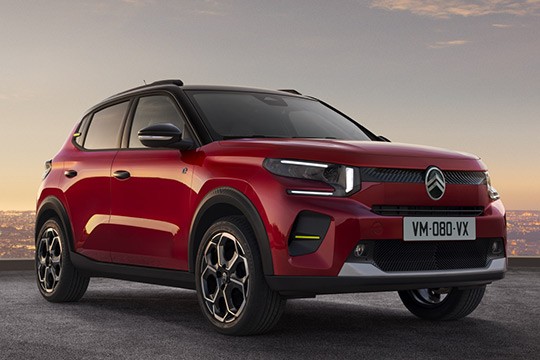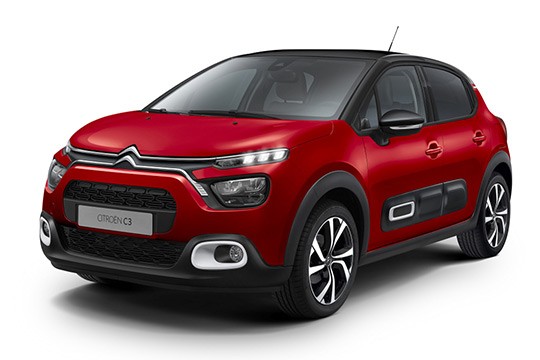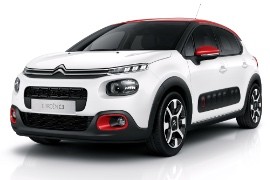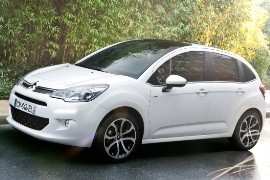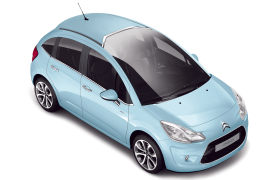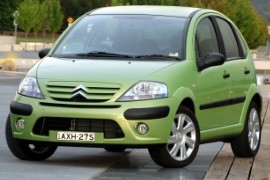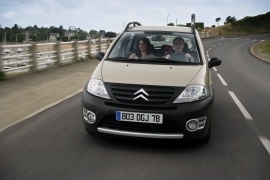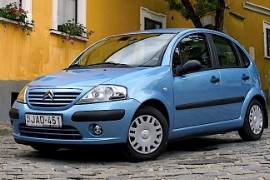CITROEN C3 Models/Series Timeline, Specifications & Photos
First production year: 2002
Engines: Gasoline, Diesel, Natural gas
Body style: Hatchback
The battle for the small-sized urban electric crossover was amplified in late 2023 when Citroen introduced the e-C3 in its lineup, challenging the best-selling nameplate in the segment, the Dacia Spring.
Big automakers reacted slowly to the new EV revolution, but after they established all their workflows and procedures, their reaction was powerful. One of these automakers was Citroen. Even though the French car manufacturer was already present on the market with a few electric and electrified versions, it didn’t cover one of the most active segments: small-sized crossovers. There, Renault enjoyed strong sales thanks to its sub-brand Dacia from Romania. That vehicle was built in China and sold in Europe with excellent results. Unlike its competitor, Citroen made the e-C3 in Europe to shorten the logistic chain. Furthermore, the ë-C3 was built on the Stellantis “Smart Car” platform, which could also get an internal combustion engine since the battery pack was underneath the rear seats.
The 2023 e-C3 was the first production model that sported the new old badge used by the French automaker between 1919 and 1932 and then again between 1935 and 1959. The “double chevron” was chromed on a black background, making it more visible. On the almost flat front fascia, the automaker placed the headlights on the upper side and featured multiple LED blocks that created a 3D effect despite their even layout. On the bumper, the automaker created several cuts and air intakes to conceal that element’s height and adorned it with a silver trim on its lower that mimicked an underbody shield. From its profile, the B-segment vehicle revealed a tall greenhouse with black B- and C-pillars and a tilted-forward D-pillar. At the back, the e-C3 had a set of taillights that replicated the design of the headlights, although with red LEDs. Finally, the rear bumper was mostly black but with a light-gray trim on its bottom.
Inside, the vehicle was very spacious for the front occupants, thanks to the tall greenhouse. The dashboard looked more like a shelf, with the instrument cluster placed far from the driver at the bottom of the windshield. In addition, the automaker offered a head-up display and a 10.25” touchscreen placed in the middle, in a free-floating position. The flat seats were designed mostly for comfort and had very little side bolstering. In the back, Citroen used the “sofa-design” concept when it made the bench seat and offered a split-folding (60/40) seatback only as an option.
But the most significant part of the car was the platform. It featured a system named Progressive Hydraulic Cushions that greatly enhanced comfort. Unlike all other cars on the market, the e-C3 had the dampers mounted on the bodywork via progressive hydraulic bump stops. As a result, there were fewer shocks felt by the car’s occupants. Under the hood, Citroen installed a 113 PS (111 hp) that offered the car an 11-second acceleration from 0 to 100 kph (0-62 mph). The 44 kWh LFP (Lithium-Iron Phosphate) battery pack ensured the vehicle a 320 km (199 miles) range. Owners could replenish the energy from up to 100 kW charging stations.
The sub-compact car was very well received by the market and, even in 2019, was still placed on the top 5 selling vehicles in its segment across Europe. The first two generations were kind of conservative, but the third one has changed its exterior shape and has been improved with a bolder look.
The mid-cycle facelift has kept the model's overall look but its stance has been improved. New LED headlights, new 17” alloy wheels, and bigger airbumps have also improved the vehicle's look. The side airbumps protect the vehicle from small dents in parking lots. As some you know, in Europe, parking lots are small, designed for the cars of yesteryear.
Inside, there are numerous upgrades, all together with 11 active-safety systems and a new infotainment unit that can be connected to the Internet via Apple CarPlay and Android Auto. The revamped C3 also comes with a connected camera that can record and store automatically 90 seconds after an accident, to be used as a witness. It records 30 seconds before an impact and 60 seconds after.
Under the hood, Citroen brought new engines adhering to the strictest Euro 6 norms. It has two variants of the same turbocharged 1.2-liter three cylinder gasoline engine with 83 and 110 hp, respectively, and two 1.5-liter turbodiesels, which are offering 100 hp and 110 hp, respectively. The latter one is offered only with a 6-speed automatic transmission.
The third generation of the Citroen C3 was shown in June 2016. While it wasn't a class-leader for the small-size segment, it was stylish and had some tempting equipment.
The French brand had made a name of itself for building small cars in big numbers. The Citroen styling has been always different from the rest of the car industry. Sometimes it was ahead of its competitors and sometimes it lacked inspiration. For the 2016 C3 though, it featured some interesting ideas for a daily driver into a crowded city.
The front fascia was the most intriguing, with its "eyebrows" of LED, daytime running lights, over the headlights. The headlights were sculptured deep inside the front bumper to protect them for small bumps in the parking lot and the fog-lights had colored rims around. From the side, the black plastic, protections against shopping carts, and door scratches may have been looked odd, but they did their job. After all, it was cheaper to fix the plastic than to replace the door. The rear, highly mounted, taillights were LED and well protected against small accidents.
Inside, the C3 had an airy appearance, with a low and flat dashboard. The infotainment unit featured a 7" touch-screen display, compatible with Apple CarPlay and Android Auto. The car offered enough room for up to five passengers and a small trunk. While it won't' offer too much comfort for long journeys, it was enough for city trips. An interesting feature of the vehicle was a screen-mounted dashcam that could record the traffic ahead and share it on social media.
Under the hood, there were few engines and gearboxes available, including an automatic for selected engines.
After four years on the market, the small-sized C3 received a well-deserved facelift that brought it essential upgrades and fixed some of the issues encountered on the 2009 model.
When Citroen launched the C3 in 2009, it did it during the world economic crisis and had to take a few cost-cutting measures. The result was an adequate vehicle for the price range it competed in. On the other hand, the French engineers knew that they could offer more, but the bean counters imposed their rules. By 2013, on the other hand, the market was already rising. Moreover, the Euro6 emission standards were due to enter in September 2014, and the non-facelifted version didn't comply.
There were significant changes at the front fascia that had received LED daytime running lights in the bumper, under the headlights, and above the foglamps' clusters. Moreover, a "smiling" lower grille complemented the upper one that was too slim to ensure the necessary amount of air needed to cool the engine. Another important upgrade was for the taillights, which were new and sported a chromed upper "eyebrow."
Unfortunately, Citroen couldn't upgrade the car's interior too much. It enhanced some materials, but basically, it was the same vehicle. On the other hand, it managed to offer as an option a new infotainment system that was fitted with a jack plug, apart from the Bluetooth connectivity and the USB slot.
Under the hood, Citroen introduced upgraded engines. The base version was still the 1.1-liter powerplant, but it offered 8 hp (8 PS) more than its predecessor. Moreover, the turbo-diesel versions were adapted for the Euro6 emission standards.
The second generation of the Citroen C3 was unveiled at the 2009 Frankfurt Motorshow. It was built on the same PF1 platform, used by the French group since 1998.
With a new design and new features, the second generation of the Citroen C3 appeared as a completely new car. But the reality was that it was a new shape on an old platform, and fitted with the engines from the previous generation of the C3.
From the outside, the curved look of the car looked appealing for most of its target customers. Its headlights were inspired by a boomerang and the grille was moved completely in the bumper and apron. As an option, the car was fitted with the “Zenith” windshield that was extended on the roof. In the back, the taillights featured the same boomerang style but reversed. To protect them from small bumps in parking lots, these were mounted upper.
Inside, the dashboard design continued the flowing-line theme from the outside. There was a choice of chrome and black trim and a choice of upholstery styles, including leather. In the instrument cluster, there were two dials and an LCD between them. Citroen dropped the coolant temperature dial and replaced it with a small lamp, which was blue when the engine was cold and red when it was too hot.
For the engine compartment, the 2009 C3 was fitted with the same “Prince” engine family developed together with BMW and re-named as PSA TU engines. The C3 was available with a choice of manual and automatic gearboxes.
Citroen upgraded its C3 range for the 2005 year and brought new technologies for its five-door, small-segment contender.
Starting with 2005, all new cars sold within European Union had to comply with the Euro 4 norms and, since that was the most important market for the French carmaker, it had to adapt. But Citroen wasn't concerned only about the emissions; it took into consideration the design as well.
While the exterior was still trendy among its customers, Citroen considered adding a refresh for the front fascia. Its grille received a new design with narrower gaps between the slats, while the lower bumper lost its two horizontal bars and showed a bigger, trapezoidal-shaped air intake. In the back, the 2009 C3 received new taillights with clear-lenses over the reversing light's area. The small-segment vehicle featured black rubber strips over the bumpers and on the door panels depending on the trim level.
Citroen refreshed the car's interior and installed a new dashboard with a redesigned center stack. Its audio system was improved as well. The French carmaker upgraded the materials for specific trim levels.
Under the hood, Citroen upgraded all its engines to comply with the Euro 4 emission standards and included a new 1.6-liter turbo-diesel engine. For specific versions, the carmaker offered an option for four-speed automatic transmissions, while the five-speed manual was fitted as standard.
Citroen saw the rise of the crossover segment and prepared a modified regular, small-segment C3, and made it look like an offroad-wannabe vehicle.
Honda introduced the HR-V's first generation in 1998 and made people understand that they can drive on unpaved roads the same car they drove to their work and still get a decent fuel efficiency. The British carmaker Rover tried the same in 2003, but with minimal success. Then, Citroen introduced the C3 X-TR. It was a front-wheel-drive vehicle that promised a good ride on a country road and more confidence while parking in tight spots.
The French carmaker added black bumpers both front and rear and added a new set of side sills branded X-TR. As an innovative brand, Citroen installed a set of roof-rails, which the driver could install lengthwise or sideways. In the U.K, the car featured a standard panoramic glass roof, while the rest of the Europeans had to pay for it.
Inside, it was just a regular C3, but with fewer color options for upholstery. It featured flat seats at the front and a low center console. The center stack featured a silver aluminum trim made out of plastic, and the same went with the air vents.
Thanks to its higher ground clearance than the regular C3, the X-TR version offered more confidence when parking over a curb or passing through a flooded street. Those who used it in the winter appreciated the option for a limited-slip differential.
Following its tradition to have supermini vehicles in its lineup, the French carmaker prepared a successor for the five-door Saxo, overlapping it for a couple of years.
Citroen introduced the first generation of the C3 at the 2001 Frankfurt Motorshow, but its presence was shadowed by the 9/11 terrorist attack that happened during the press days of the motoring event. The car benefited from the second launch in December 2001 at the Bologna motor show and received more attention.
Its rounded shapes evoked the glorious past of the Citroen 2CV. The short front overhang and hood and the arched greenhouse were all part of the same theme. The carmaker chose not to make a three-door version for it, just like the 2 CV. At the front, the angular-shaped headlights and the slatted grille looked different than on its famous predecessor but followed the same rules. Its wrapped-around bumper sported black rubber strips, placed on the corners to avoid trading paint in parking. Citroen used other rubber strips on the doors for the same reason.
Inside, the car was surprisingly roomy for its size. Its arched roof allowed good headroom for all passengers, despite its high-mounted seats. The dashboard was created with curved lines, and the rounded instrument cluster featured a wide tachometer at the top while the speedometer was on a digital display in the middle of the instrument panel. Citroen installed an additional screen for the trip computer on the dashboard above the center stack.
Under the hood, the carmaker installed a wide engine choice, both gasoline, and turbo-diesel. All versions were paired to a five-speed manual, while selected versions were mated to an automated five-speed gearbox.
